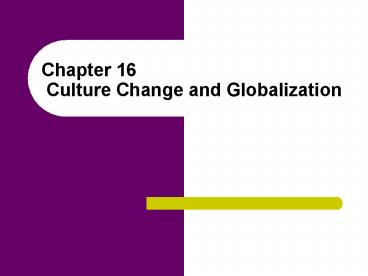Chapter 16 Culture Change and Globalization - PowerPoint PPT Presentation
1 / 19
Title:
Chapter 16 Culture Change and Globalization
Description:
Title: Chapter 16 Author: Stacy Schoolfield Last modified by: Stacy Schoolfield Created Date: 4/24/2003 6:10:38 PM Document presentation format: On-screen Show – PowerPoint PPT presentation
Number of Views:97
Avg rating:3.0/5.0
Title: Chapter 16 Culture Change and Globalization
1
Chapter 16 Culture Change and Globalization
2
Chapter Outline
- Inventions/Innovations
- Diffusion
- Acculturation
- Linked Changes
- Obstacles to Cultural Change
- Cultural Survival of Indigenous Peoples
- Urbanization and Change
- Change and Development
- Globalization and World Cultures
3
Cultural Change
- No culture remains unchanged.
- Cultures change in two ways
- Internally - through the processes of invention
and innovation - Externally through the process of diffusion.
4
Inventors and Innovators
- Inventors and innovators tend to be marginal
people living on the fringes of society. - Not bound by tradition or convention, these
people see problems and their solutions with a
fresh perspective. - Many come from from upper-class, wealthy, and
well-educated segments of society.
5
Cultural Diffusion Selectivity
- The adoption of an innovation by a culture and
the speed with which it is adopted depends on the
following - Is it seen as superior to what already exists?
- Is it consistent with existing cultural patterns?
- Is it easily understood?
- Can it be tested on a trial basis?
- Are the benefits clearly visible?
6
Cultural Diffusion Reciprocity
- Diffusion is a two-way process.
- While Europeans introduced their culture to
Native Americans, they received cultural features
in return - Clothing - ponchos, parkas, and moccasins
- medicines - quinine, pain relievers, and
laxatives - food - corn, beans, tomatoes, squash, yams,
avocados, and the so-called Irish potato
7
Cultural Diffusion Modification
- Once a cultural element is accepted in a new
culture, it may change in form or function. - The Masai of Kenya and Tanzania pierce their
earlobes and enlarge the hole by inserting
increasingly larger round pieces of wood until a
loop of skin is formed. - One group of Masai was observed using Eveready
flashlight batteries obtained from the U.S.
8
Cultural Diffusion Likelihood
- Some parts of culture are more likely to be
diffused than others. - Items of material culture are more likely
candidates for diffusion than ideas or behavior
patterns. - A traditional farmer in Senegal is more likely to
be convinced of the advantages of a bulldozer
over a shovel than of substituting Buddhism for
his form of ancestor worship.
9
Cultural Diffusion Variables
- Diffusion is affected by a number of important
variables - duration and intensity of contact
- degree of cultural integration
- similarities between the donor and recipient
cultures
10
Acculturation
- Takes place as a result of sustained contact
between two societies, one of which is
subordinate to the other. - Involves the widespread reorganization of one or
both cultures over a short period of time. - Both the dominant and subordinate culture
experience changes, but the subordinate culture
changes most dramatically.
11
Consequences of Acculturation
- The subordinate culture could
- become extinct
- be incorporated as a distinct subculture of the
dominant group - be assimilated (blended) into the dominant group
12
Linked Changes
- A single innovation may set off a series of
changes in other parts of the culture. - Example television
- Introduced into U.S. society during 1950s.
- Replaced the the radio as the major form of
electronic communication in U.S. households. - Had far-reaching consequences for other parts of
the culture, such as the family system, the
political process, and our religious institutions.
13
Cultural Boundaries
- Strengthen a cultures traditions and discourage
cultural borrowing - Language
- Eating habits
- Clothing
- Folklore
- Humor
14
Indigenous Populations
- Refers to a group of people who are
- Original inhabitants of a region.
- Identify with a specific, small-scale cultural
heritage. - Have no significant role in the government.
- Examples the small-scale cultures in Asia,
Africa, and the Americas that came under the
influence of the colonial powers during the past
several centuries.
15
Urbanization and Change
- 1900 - 16 cities with a population of a million
or more people. - 1990 - 276 cities with a population of a million
or more people. - 1990 37 of the worlds population will be
urban. - 2025 - estimated that approximately 60 of the
worlds population will be urban.
16
Urban Growth in the U.S.
- Percent of population living in cities
- 1790 - 5 of the population
- 1850 - 14 of the population
- 1920 - 50 of the population
- 2000 - 75 of the population
17
The Worlds 10 Largest Cities
City Country Population 2002 millions Projected Population 2015 millions
1 Tokyo Japan 26.4 26.4
2 Mexico City Mexico 18.1 19.2
3 Mumbai India 18.0 26.1
4 São Paulo Brazil 17.6 20.4
5 New York USA 16.6 17.4
18
The Worlds 10 Largest Cities
City Country Population 2002 millions Projected Population 2015 millions
6 Lagos Nigeria 13.4 23.2
7 Los Angeles USA 13.1 14.1
8 Calcutta India 12.9 17.3
9 Shanghai China 12.9 14.6
10 Buenos Aires Argentina 12.6 14.1
19
Factors in the the Rise of Globalization
- Revolution in computer technology made
communication faster and cheaper for a growing
segment of the worlds population. - Methods of investing money has changed, today it
is, to a large degree, in the hands of
individuals. - There has been a fundamental change in the flow
of information all over the world.































